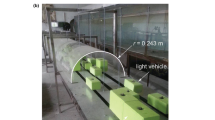Abstract
Three-dimensional turbulent flow and dispersion of gaseous pollutants carbon monoxide (CO) and nitrogen oxides (NOx) in a road tunnel was modeled using the standard k–ε turbulence model and solved numerically using the finite volume method. Vehicle emissions were estimated from the measured traffic flow rates and modeled as banded line sources along the tunnel floor. The effects of fan ventilation and piston effect of moving vehicles on the airflow and pollutant dilution were examined. The numerical results reveal that a peak velocity exists near the tunnel floor due to the piston effect of vehicles. The cross-sectional concentrations of air pollutants are non-uniformly distributed and concentrations rise with downstream distance. The piston effect of vehicles can alone provide 25%–34% dilution of air pollutants in the tunnel, compounded 43%–70% dilution effect according to the ventilation condition.
Similar content being viewed by others
References
AEA Technology (1997). CFX Manual Solver (4.2). Oxfordshire, United Kingdom.
Baik, J. J., & Kim, J. J. (1999). A numerical study of flow and pollutant dispersion characteristics in urban street canyons. Journal of Applied Meteorology, 38, 1576–1589.
Bellasio, R. (1997). Modelling traffic air pollution in road tunnels. Atmospheric Environment, 31, 1539–1551.
Bring, A., Malmstrom, T. G., & Boman, C. A. (1997). Simulation and measurement of road tunnel ventilation. Tunneling and Underground Space Technology, 12, 417–424.
Chang, Y. R., & Chen, K. S. (1995). Prediction of opposing turbulent line jets discharged laterally into a confined cross flow. International Journal of Heat and Mass Transfer, 38, 1693–1703.
Chang, T. Y., Modzelewski, S. W., & Norbeck, J. M., Pierson, W. R. (1981). Tunnel air quality and vehicle emissions. Atmospheric Environment, 15, 1011–1016.
Chang, T. Y., & Rudy, S. J. (1990). Road tunnel air quality models. Environmental Science & Technology, 24, 672–676.
Chen, K. S., Chung, C. Y., & Wang, S. W. (2002). Measurements and three-dimensional modeling of airflow and pollutant dispersion in an undersea traffic tunnel. Journal of the Air & Waste Management Association, 52, 349–363.
Chen, T. Y., Lee, Y. T., & Hsu, C. C. (1998). Investigations of piston-effect and jet fan-effect in model vehicle tunnels. Journal of Wind Engineering and Industrial Aerodynamics, 73, 99–110.
Chung, C. Y. (2002). Investigations of Three Dimensional Air Flow and Pollutant Dispersion in Traffic Tunnels. PhD dissertation, Institute of Environmental Engineering, National Sun Yat-Sen University, Kaohsiung, Taiwan.
El-Fadel, M., & Hashisho, Z. (2000). Vehicular emissions and air quality assessment in roadway tunnels: The Salim Slam tunnel. Transportation Research, Part D5, 355–372.
Kagawa, J. (1984). Health effects of air pollutants and their management. Atmospheric Environment, 18, 613–620.
Launder, B. E., & Spalding, D. B. (1974). Numerical computation of turbulent flows. Computer Methods in Applied Mechanics and Engineering, 3, 269–289.
Liou, T. M., Chang, Y., & Hwang, D. W. (1990). Experimental and computational study of turbulent flows in a channel with two pairs of turbulence promoters in tandem. ASME Journal of Fluids Engineering, 112, 302–310.
Patankar, S. V. (1980). Numerical heat transfer and fluid flow. New York: McGraw-Hill.
Patankar, S. V., Basu, D. K., & Alpay, S. A. (1977). Predictions of the three-dimensional velocity field of a deflected turbulent jet. ASME Journal of Fluids Engineering, 99, 493–504.
PIARC (1991). Technical Committee on Road Tunnels, Reports, XIXth World Road Congress, Marrakesh.
Schwartz, J., & Morris, R. (1995). Air pollution and hospital admissions for cardiovascular disease in Detroit, Michigan. American Journal of Epidemiology, 142, 23–35.
Sini, J. F., Anquetin, S., & Mestayer, P. G. (1996). Pollutant dispersion and thermal effects in urban street canyons. Atmospheric Environment, 30, 2659–2677.
Sini, J. F., & Dekeyser, I. (1989). Numerical prediction of turbulent plane buoyant jets discharging in a stratified stagnant or flow ocean. Numerical Heat Transfer, 16, 371–387.
Strom, C. R. (1973). Aerodynamic analysis of vehicles in tunnel, Int. Sympo. on the Aerodynamics & Ventilation of Vehicle Tunnels, Paper C2, 17–42.
TANEEB (1991). The Preliminary Study on The Ventilation of Long Highway Tunnels in Kaohsiung City, Taiwan Area National Expressway Engineering Bureau, Ministry of Transportation and Communication.
White, F. M. (1991). Viscous fluid flow. 2nd Ed., New York: McGraw-Hill 426–493.
Author information
Authors and Affiliations
Corresponding author
Rights and permissions
About this article
Cite this article
Chung, CY., Chung, PL. A Numerical and Experimental Study of Pollutant Dispersion in a Traffic Tunnel. Environ Monit Assess 130, 289–299 (2007). https://doi.org/10.1007/s10661-006-9397-0
Received:
Accepted:
Published:
Issue Date:
DOI: https://doi.org/10.1007/s10661-006-9397-0




